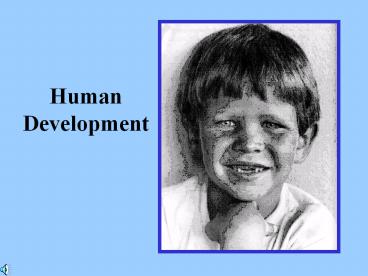Human Development - PowerPoint PPT Presentation
1 / 27
Title:
Human Development
Description:
Human Development Growth: generally refers to changes in size Development: occurs through maturation of physical & mental capacities & learning Life Stages Infancy ... – PowerPoint PPT presentation
Number of Views:74
Avg rating:3.0/5.0
Title: Human Development
1
Human Development
2
Growth generally refers to changes in size
3
Developmentoccurs through maturation of
physical mental capacities learning
4
Life Stages
5
Infancy
6
- language of newborn is the cry
- usually eats every 2 to 3 hours
- uncoordinated movements
- toothless
- poor vision (focusing range 8 to 12 inches)
- usually doubles weight by 9 months
- responds to human voice touch
7
Early Childhood
8
One-Year Old
9
- change from plump baby to leaner more
muscular toddler - begins to walk talk
- ability for passive language (better
understanding of whats being said) - tentative sense of independence
- determined explorer
10
Two-Year Old
11
- begins to communicate verbally (name, etc.)
- can usually speak in 3 to 4 word sentences
- famous for negative behavior
- NO! to everything!
- temper tantrums
- will play side by side other children, but does
not actively play with them - great imitators
12
Three-Year Old
13
- wants to be just like parents
- vocabulary and pronunciation continue to expand
- climbs stairs with alternating feet
- can briefly stand on one foot
14
Four-Year Old
15
- sentences are more complex speaks well enough
for strangers to understand - imagination is vivid line between what is real
imaginary is often indistinct - develops fears (common fears fear of dark, fear
of animals, fear of death)
16
Five-Year Old
17
-can hop on one foot skip-can accurately copy
figures-may begin to read-social with other
children their age
18
Late Childhood Preadolescence
19
- both large small muscles well-developed
- developed complex motor skills
- from independent activities to same sex group
activities - acceptance by peers very important
- parental approval still important
20
Adolescence
- traumatic life stage for child parent
- puberty occurs
- extremely concerned with appearance
- trying to establish self-identity
- confrontations with authority
21
Young Adult
22
- physical development complete
- emotional maturation continues to develop
- usually learned to accept responsibility for
actions accept criticism - usually knows how to profit from errors
- socially progress from age-related peer groups to
people with similar interests
23
Middle Adulthood
24
- physical changes begin to occur
- hair begins to thin gray
- wrinkles appear
- hearing vision decrease
- muscles lose tone
- main concerns children, health, job security,
aging parents, fear of aging - love acceptance still take a major role
25
Late Adulthood
26
- fastest growing age bracket of society. 13 of
the population. 39.6 million - physical deterioration (brittle bones, poor
coordination) - some memory problems
- coping with retirement forms of entertainment
- very concerned with health finances
- significant number become depressed suicide rate
is high
27
Individual Differences To Take Into Consideration
- Cultural Subcultural differences
- value systems, rites of passage, rituals
- Ethnic differences
- skin tones, facial features, language
- Religious differences
- Physical differences
- large/small, thin/fat, anomalies, disabilities
- Personalities
- predisposition to be outgoing, shy, creative,
etc.































